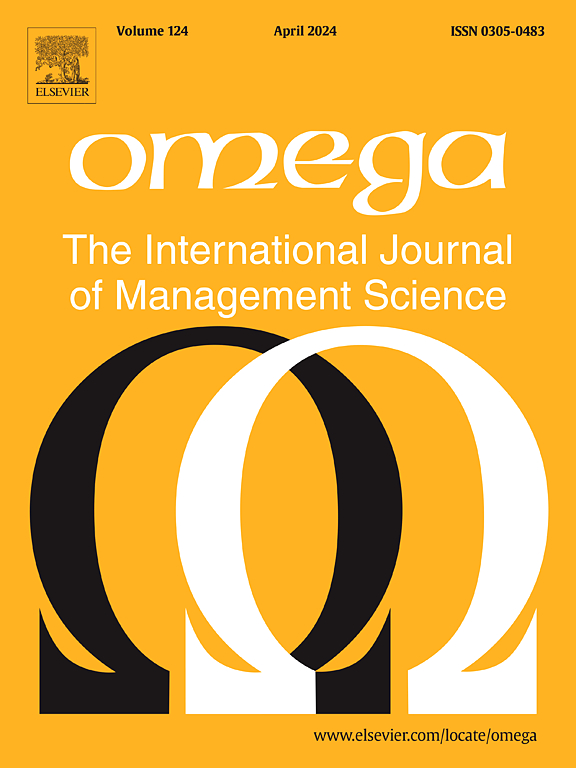Optimal sizing and location of energy storage systems for transmission grids connected to wind farms
IF 7.2
2区 管理学
Q1 MANAGEMENT
Omega-international Journal of Management Science
Pub Date : 2025-02-22
DOI:10.1016/j.omega.2025.103301
引用次数: 0
Abstract
Although modern renewable power sources such as solar and wind are increasing their share of the world’s power generation, they need to grow faster to replace a greater share of coal and gas power generation and thus, help prevent CO and other greenhouse gas emissions to reach critical levels. Renewable energy generation must be coupled with energy storage systems, which are unfortunately expensive investments. However, substantial cost savings may be possible if a system-wide solution is sought. This paper presents such an attempt for a transmission grid that has a mixture of renewable and non-renewable sources. The particular problem is to find the type, location and size of the storage systems in the grid, as well as the structure of the transmission network, to minimize total investment and system-wide operating costs of power generation, transmission and storage. A mixed integer linear programming formulation is devised for the problem, which can be very large because various operational decisions are made at short intervals. Hence, we develop a “divide-and-conquer” type solution approach based on time decomposition, wherein the problem is first solved in monthly time segments. Subsequently, optimal or near-optimal monthly generation schedules are merged to construct the greater portion of a grand schedule for the whole year. Although still considerably large, the model can be solved effectively after another set of heuristically developed restrictions on the transmission network structure. The formulation and solution method are implemented on a series of realistic instances for a modest-sized transmission grid adapted from Sardinia Island of Italy to demonstrate the effectiveness of the approach and the insight into related design decisions.
与风电场相连的输电网储能系统的最佳尺寸和位置
虽然太阳能和风能等现代可再生能源在世界发电中所占的份额正在增加,但它们需要更快地增长,以取代更大份额的煤炭和天然气发电,从而有助于防止二氧化碳和其他温室气体排放达到临界水平。可再生能源发电必须与能源存储系统相结合,不幸的是,这是昂贵的投资。但是,如果寻求全系统的解决办法,可能会节省大量费用。本文针对可再生能源和不可再生能源混合的输电网提出了这样的尝试。具体的问题是找到电网中存储系统的类型、位置和规模,以及输电网的结构,以最小化发电、输电和存储的总投资和全系统运行成本。针对该问题设计了一个混合整数线性规划公式,该公式可能非常大,因为各种操作决策是在短时间间隔内做出的。因此,我们开发了一种基于时间分解的“分而治之”类型的解决方法,其中首先在每月的时间段内解决问题。随后,合并最优或接近最优的月度发电计划,以构建全年大计划的大部分。尽管该模型仍然相当大,但在对输电网结构进行另一组启发式约束后,可以有效地求解该模型。本文以意大利撒丁岛的一个中等规模输电网为例,进行了一系列实际应用,以证明该方法的有效性和对相关设计决策的洞察力。
本文章由计算机程序翻译,如有差异,请以英文原文为准。
求助全文
约1分钟内获得全文
求助全文
来源期刊

Omega-international Journal of Management Science
管理科学-运筹学与管理科学
CiteScore
13.80
自引率
11.60%
发文量
130
审稿时长
56 days
期刊介绍:
Omega reports on developments in management, including the latest research results and applications. Original contributions and review articles describe the state of the art in specific fields or functions of management, while there are shorter critical assessments of particular management techniques. Other features of the journal are the "Memoranda" section for short communications and "Feedback", a correspondence column. Omega is both stimulating reading and an important source for practising managers, specialists in management services, operational research workers and management scientists, management consultants, academics, students and research personnel throughout the world. The material published is of high quality and relevance, written in a manner which makes it accessible to all of this wide-ranging readership. Preference will be given to papers with implications to the practice of management. Submissions of purely theoretical papers are discouraged. The review of material for publication in the journal reflects this aim.
 求助内容:
求助内容: 应助结果提醒方式:
应助结果提醒方式:


